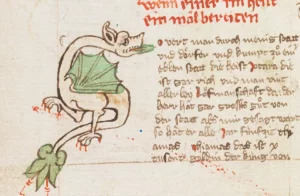 The dragon, the ultimate form of the serpent, appears in many medieval tales. Bestiaries describe their most powerful weapon as their tail, used to squeeze and suffocate prey.
The dragon, the ultimate form of the serpent, appears in many medieval tales. Bestiaries describe their most powerful weapon as their tail, used to squeeze and suffocate prey.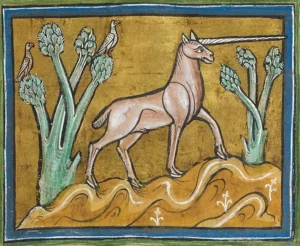 Ancient Greek writers first described unicorns as beasts with a long horn, placing them in India—likely inspired by the rhinoceros. In the Middle Ages, these creatures gained a richer mythical background. Isidore of Seville, a seventh-century writer, described the unicorn as a strong, single-horned beast capable of piercing anything it attacks.
Ancient Greek writers first described unicorns as beasts with a long horn, placing them in India—likely inspired by the rhinoceros. In the Middle Ages, these creatures gained a richer mythical background. Isidore of Seville, a seventh-century writer, described the unicorn as a strong, single-horned beast capable of piercing anything it attacks.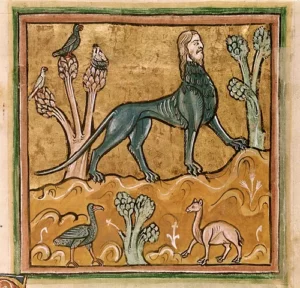 Manticores, hybrids of various animals and humans, were favourites among ancient and medieval writers. Typically described as having the head of a man, the body of a lion, and the tail of a scorpion, these beasts were both fascinating and terrifying.
Manticores, hybrids of various animals and humans, were favourites among ancient and medieval writers. Typically described as having the head of a man, the body of a lion, and the tail of a scorpion, these beasts were both fascinating and terrifying.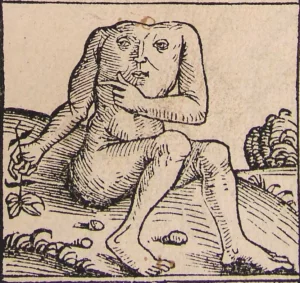 Blemmyae were common monstrous figures in medieval manuscripts, characterized by having no head, with faces located on their torsos. Some writers placed these people in Africa, beyond Ethiopia.
Blemmyae were common monstrous figures in medieval manuscripts, characterized by having no head, with faces located on their torsos. Some writers placed these people in Africa, beyond Ethiopia. Dog-headed people, or Cynocephali, were another popular subject for medieval writers. Paul the Deacon, in The History of the Lombards, tells of a Lombard strategy to intimidate a more powerful enemy by spreading rumours that their camps housed Cynocephali, fierce warriors who drank human blood. The enemy, terrified by this prospect, decided to avoid the Lombards.
Dog-headed people, or Cynocephali, were another popular subject for medieval writers. Paul the Deacon, in The History of the Lombards, tells of a Lombard strategy to intimidate a more powerful enemy by spreading rumours that their camps housed Cynocephali, fierce warriors who drank human blood. The enemy, terrified by this prospect, decided to avoid the Lombards.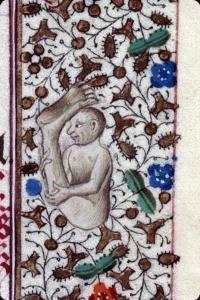 Known for having one leg with a very large foot, the Skiapodes were described by Pliny the Elder as people who “lie on their backs during extreme heat and protect themselves from the sun by the shade of their feet.”
Known for having one leg with a very large foot, the Skiapodes were described by Pliny the Elder as people who “lie on their backs during extreme heat and protect themselves from the sun by the shade of their feet.” From the tale of David and Goliath to countless medieval legends, giants often inhabited wastelands and mountains beyond human reach.
From the tale of David and Goliath to countless medieval legends, giants often inhabited wastelands and mountains beyond human reach.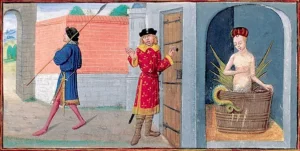 Before becoming the Starbucks logo, Melusine was a half-woman, half-serpent figure in medieval folklore.
Before becoming the Starbucks logo, Melusine was a half-woman, half-serpent figure in medieval folklore.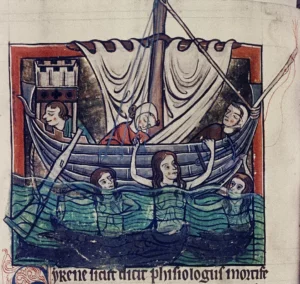 Half-human, half-fish creatures, mermaids appeared in the folklore of many medieval cultures, including those in the Middle East and Asia. They had mixed reputations: some stories depicted them helping people, while others warned of their attempts to lure men into the water to drown them.
Half-human, half-fish creatures, mermaids appeared in the folklore of many medieval cultures, including those in the Middle East and Asia. They had mixed reputations: some stories depicted them helping people, while others warned of their attempts to lure men into the water to drown them.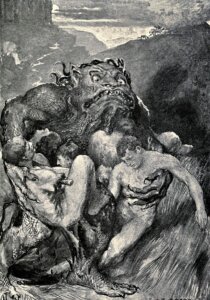 These two characters appear only in the Old English poem Beowulf, as the main antagonists of the hero. Descendants of the Biblical character Cain, they are portrayed as hideous monsters who eat men.
These two characters appear only in the Old English poem Beowulf, as the main antagonists of the hero. Descendants of the Biblical character Cain, they are portrayed as hideous monsters who eat men. Ann Marie Thomas is the author of five medieval history books, a surprisingly cheerful poetry collection about her 2010 stroke, and the science fiction series Flight of the Kestrel, Intruders, Alien Secrets & Crisis of Conscience are out now Follow her at http://eepurl.com/bbOsyz
Ann Marie Thomas is the author of five medieval history books, a surprisingly cheerful poetry collection about her 2010 stroke, and the science fiction series Flight of the Kestrel, Intruders, Alien Secrets & Crisis of Conscience are out now Follow her at http://eepurl.com/bbOsyz